The Lynnfield Preview: Rumblings of Revenge
by Anand Lal Shimpi on May 29, 2009 1:00 PM EST- Posted in
- CPUs
SYSMark 2007 Performance
Our journey starts with SYSMark 2007, the only all-encompassing performance suite in our review today. The idea here is simple: one benchmark to indicate the overall performance of your machine.
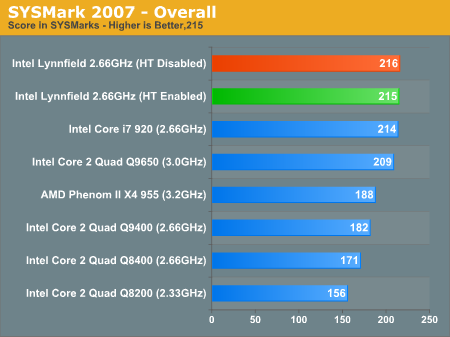
Ok. Right out of the gate, on pre-production silicon, with a pre-production motherboard and without a super aggressive turbo-mode the 2.66GHz Lynnfield sample is able to perform just as well as the i7-920. This is just as we expected given the minimal impact of triple-channel DDR3 on i7 that we pointed out in our original review.
Curiously enough, HT doesn't seem to do anything at all for Lynnfield in this test. Remember that stressing four cores is tough enough, finding eight CPU intensive threads is even more difficult.
Adobe Photoshop CS4 Performance
To measure performance under Photoshop CS4 we turn to the Retouch Artists’ Speed Test. The test does basic photo editing; there are a couple of color space conversions, many layer creations, color curve adjustment, image and canvas size adjustment, unsharp mask, and finally a gaussian blur performed on the entire image.
The whole process is timed and thanks to the use of Intel's X25-M SSD as our test bed hard drive, performance is far more predictable than back when we used to test on mechanical disks.
Time is reported in seconds and the lower numbers mean better performance. The test is multithreaded and can hit all four cores in a quad-core machine.
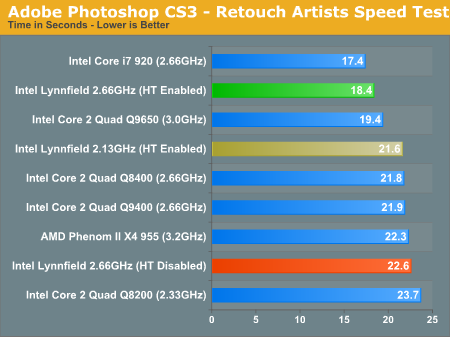
DivX 8.5.3 with Xmpeg 5.0.3
Our DivX test is the same DivX / XMpeg 5.03 test we've run for the past few years now, the 1080p source file is encoded using the unconstrained DivX profile, quality/performance is set balanced at 5 and enhanced multithreading is enabled:
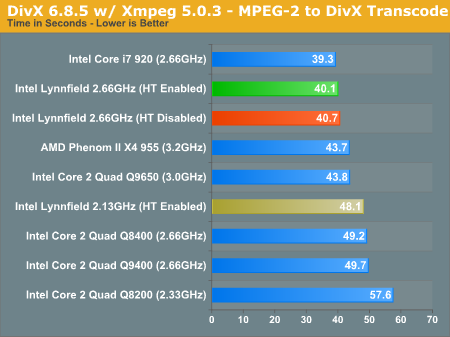
Once more, we see very little impact from Hyper Threading; the entry level Lynnfield may not be as bad as you'd think. On top of that, the crippled Lynnfield is less than 4% slower than the Core i7-920. Enable its aggressive turbo mode and I believe we'll have a chip that can actually beat, even if only slightly, the Core i7-920.
x264 HD Video Encoding Performance
Graysky's x264 HD test uses the publicly available x264 codec (open source alternative to H.264) to encode a 4Mbps 720p MPEG-2 source. The focus here is on quality rather than speed, thus the benchmark uses a 2-pass encode and reports the average frame rate in each pass.

The x264 encode test shows one application where Hyper Threading is important. A 2.13GHz Lynnfield with HT enabled is faster than a 2.66GHz Lynnfield with HT disabled, unfortunately the former isn't on the roadmap and the latter is what we're getting.
Without HT enabled the $196 Lynnfield 2.66GHz core is faster than every non-EE Penryn Core 2 Quad as well as AMD's Phenom II X4 955 (in the second pass of the test). The i7-920 is significantly faster thanks to having HT enabled; and now we have the perfect reason for Intel disabling HT on the "low end" Lynnfield.
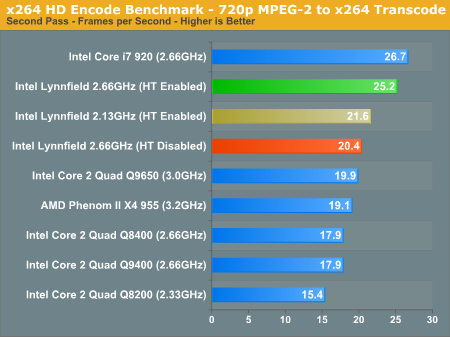
Windows Media Encoder 9 x64 Advanced Profile
In order to be codec agnostic we've got a Windows Media Encoder benchmark looking at the same sort of thing we've been doing in the DivX and x264 tests, but using WME instead.
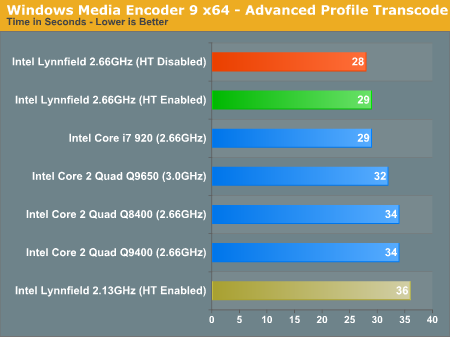
Tests that don't scale well with HT enabled, once again, show no performance difference between a 2.66GHz Lynnfield and a 2.66GHz Bloomfield.










95 Comments
View All Comments
Hyperion1400 - Friday, May 29, 2009 - link
*Presses imaginary edit button*"Don't forget, Istanbul is heading..."
MadMan007 - Friday, May 29, 2009 - link
Awesome preview, too bad about HT.I think there's an error with the labelling for the first pass x264 encoding test on pg 7.
dwade123 - Friday, May 29, 2009 - link
i5 is perfect for ITX motherboard compared to i7. Can't wait!!!nubie - Friday, May 29, 2009 - link
+1 they need to get an ITX motherboard for these immediately, if not sooner!One chip motherboard with integrated PCI-e x16 is perfect for ITX gaming system, should drive the cost of them way way down :)
Dual x8 PCI-e 2.0 is fine for Crossfire or SLi (not that I would ever plan to run them)
Is there any chance of an nVidia 9800/GTS250 integrated ITX motherboard? I would just about die if you could get one of those for around $200 ;)
Mr Perfect - Friday, May 29, 2009 - link
Absolutely! Can you imagine all that horsepower in such a small FF? Hopefully Zotac makes another mini-ITX with a x16 slot on it.Depeche - Friday, May 29, 2009 - link
By the time I got the i7 the i5 comes out and when I finally get the i5 some other series comes out. I can't keep up :)Get these CPUs in the Bench Beta :P
A5 - Friday, May 29, 2009 - link
This kind of thing (and the motherboard round-ups that used to be here) were the reasons I came to AT. If this pans out, I'm definitely building a Lynnfield system to replace my aging Socket-939 rig.philosofool - Monday, August 3, 2009 - link
As a bonus, if you buy into LGA 1156 now, you will probably be able to get a considerable upgrade in 2 years just by replacing the CPU. The LGA 1156 socket should last awhile, at least as long as LGA 775, but maybe longer, because the memory controller was the big reason for a new socket.nuudles - Monday, June 1, 2009 - link
I agree, great article!I also have only an an old s939 rig (opteron 150 - so i am still in the single-core world), and I also suspect this is the one I have been waiting for:)
I initially thought I would wait a bit longer till the 32nm parts come out (damn Intel for their tick-tock), but since the first 32nm parts will be more mainstream (2C/4T) where the Lynnfields are high-end mainstream (or whatever its called) I think the 2.8 Lynnfield would suit me nicely for the next 3-4 years.
faxon - Monday, June 1, 2009 - link
yea i would wait man. i upgraded from my 939 rig to an e5200 and now i have a Q9650 @ 4GHz @ 1.296vcore. given the performance benchmarks, even a 3.7ghz lynnfield will probably outperform my 4GHZ quad in games